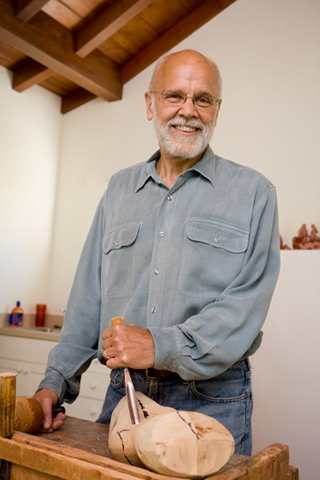When I was a boy I used to enjoy carving wooden ship models. The hulls appealed to me not only as miniature versions of romanticized objects, but as abstract forms that could create an illusion of floating in space. I shifted from ships to sculpture when I was in college, completing several small pieces. My path jogged then, as I directed my attention to medical school, and eventually became a psychiatrist and a psychoanalyst. I continued to work with wood, however, making mobiles, designing and building wooden furniture, and doing a variety of carpentry projects for our home. Many years later I came back to sculpture, drawn by the pleasure in the process of carving, a desire to work with wood in a more exploratory way, and a wish to create expressive, rather than purely utilitarian, forms.
In some ways, I see my sculpture as an extension of what drew me to psychoanalysis, an interest in inner states and their hidden potentials. As a living material, wood is especially suited to evoke reflections on the processes of life--growth, sexuality, death, transformation--and development over time. My abstract pieces are often hollowed out or composed of sections arranged in such a way that light enters the interior of the piece from sources that are hidden from some viewing points. I want this to express a sense of inwardness and mystery.
I often pose even figurative pieces to create a sense of enclosure and inner space, either between elements such as arms, legs, and body, or under the body. In some figurative work I have carried this farther by dividing the figure into pieces, so that the spaces between parts contribute to the feeling of hidden inner venues. By dividing the figure, like cropping a photograph, I’m also trying to highlight abstract qualities such as volume and weight, and to express the way that some forms seem to surrender to gravity while others defy it.
Further, I want to invite comparison to natural forms like sand dunes, weathered rock, or driftwood. In some recent work, I’ve been exploring shapes based even more explicitly on river-worn rocks. Both the shapes themselves and the patterns of the grain on the surfaces of the pieces evoke the flow of water. Through these analogies I am using sculpture as a meditation on temporal processes, involving both coming to be and passing away.
A three dimensional form only reveals itself in time, as the observer moves around a piece, viewing it from different angles. The form changes as the viewer moves, perhaps seeming stable and still in some views, mobile or even precarious in others. In this way too, I want my sculpture to evoke the experience of movement, of changing states, and the passage of time.
Juried Exhibitions:1996 “Icons of Power”
1996 Peninsula Art Association
Juror: Peter Selz
Juror: Steven Nash
Professional Groups:
International Sculpture Center
Peninsula Sculptors’ Guild
Gallery M, Half Moon Bay, California
1996-present

